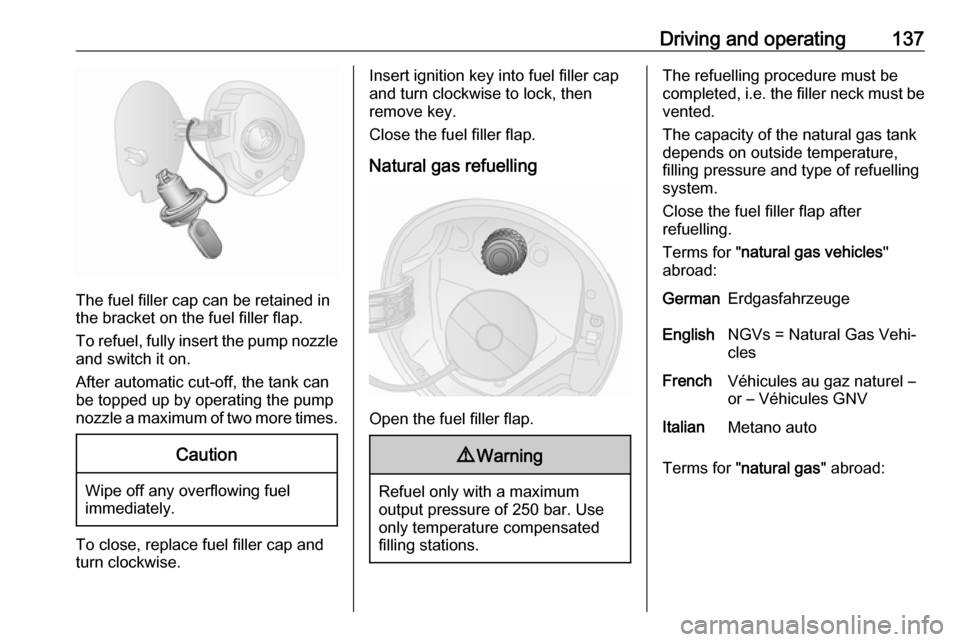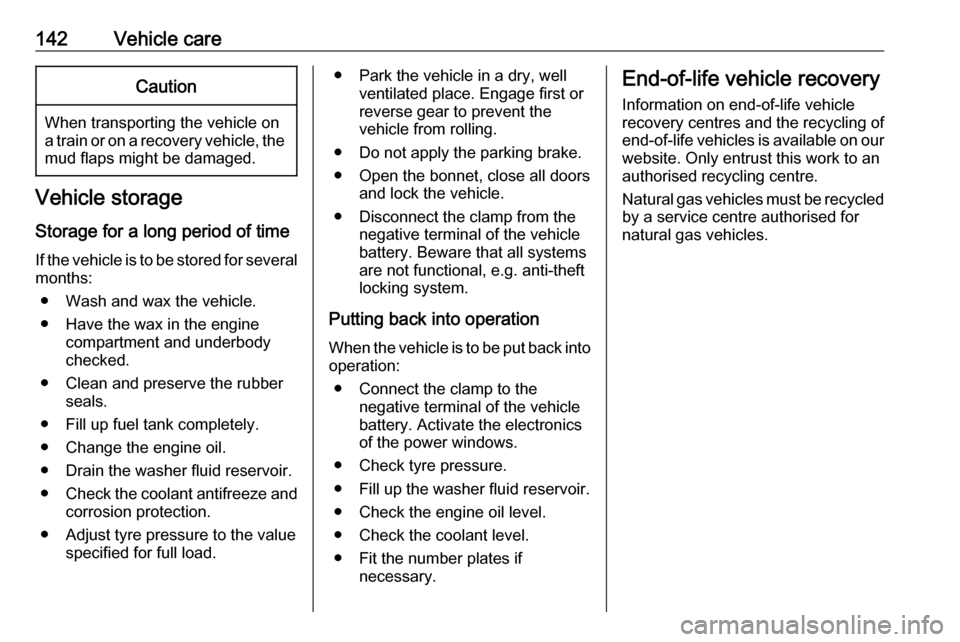open gas tank OPEL COMBO D 2018 Manual user
[x] Cancel search | Manufacturer: OPEL, Model Year: 2018, Model line: COMBO D, Model: OPEL COMBO D 2018Pages: 203, PDF Size: 4.97 MB
Page 139 of 203

Driving and operating137
The fuel filler cap can be retained in
the bracket on the fuel filler flap.
To refuel, fully insert the pump nozzle
and switch it on.
After automatic cut-off, the tank can be topped up by operating the pump
nozzle a maximum of two more times.
Caution
Wipe off any overflowing fuel
immediately.
To close, replace fuel filler cap and
turn clockwise.
Insert ignition key into fuel filler cap
and turn clockwise to lock, then
remove key.
Close the fuel filler flap.
Natural gas refuelling
Open the fuel filler flap.
9 Warning
Refuel only with a maximum
output pressure of 250 bar. Use
only temperature compensated
filling stations.
The refuelling procedure must be
completed, i.e. the filler neck must be vented.
The capacity of the natural gas tank
depends on outside temperature,
filling pressure and type of refuelling
system.
Close the fuel filler flap after
refuelling.
Terms for " natural gas vehicles "
abroad:GermanErdgasfahrzeugeEnglishNGVs = Natural Gas Vehi‐
clesFrenchVéhicules au gaz naturel –
or – Véhicules GNVItalianMetano auto
Terms for " natural gas " abroad:
Page 144 of 203

142Vehicle careCaution
When transporting the vehicle on
a train or on a recovery vehicle, the
mud flaps might be damaged.
Vehicle storage
Storage for a long period of time
If the vehicle is to be stored for several months:
● Wash and wax the vehicle.
● Have the wax in the engine compartment and underbody
checked.
● Clean and preserve the rubber seals.
● Fill up fuel tank completely.
● Change the engine oil.
● Drain the washer fluid reservoir.
● Check the coolant antifreeze and
corrosion protection.
● Adjust tyre pressure to the value specified for full load.
● Park the vehicle in a dry, wellventilated place. Engage first or
reverse gear to prevent the
vehicle from rolling.
● Do not apply the parking brake.
● Open the bonnet, close all doors and lock the vehicle.
● Disconnect the clamp from the negative terminal of the vehicle
battery. Beware that all systems
are not functional, e.g. anti-theft
locking system.
Putting back into operation
When the vehicle is to be put back into operation:
● Connect the clamp to the negative terminal of the vehicle
battery. Activate the electronics
of the power windows.
● Check tyre pressure.
● Fill up the washer fluid reservoir.
● Check the engine oil level.
● Check the coolant level.
● Fit the number plates if necessary.End-of-life vehicle recovery
Information on end-of-life vehicle
recovery centres and the recycling of
end-of-life vehicles is available on our website. Only entrust this work to an
authorised recycling centre.
Natural gas vehicles must be recycled by a service centre authorised for
natural gas vehicles.
Page 199 of 203

197Chimes......................................... 96
Cigarette lighter ........................... 76
Climate control ............................. 16
Climate control systems .............107
Clock....................................... 73, 91
CNG.............................. 78, 136, 190
Collision damage repair ..............193
Control indicators.......................... 80
Control of the vehicle .................114
Controls ........................................ 71
Convex shape .............................. 30
Coolant and antifreeze ...............178
Cruise control ...................... 91, 131
Cupholders .................................. 62
D
Danger, Warnings and Cautions ...4
Date .............................................. 91
Daytime running lights ..........91, 101
Declaration of conformity ............192
Diesel particle filter ...............87, 121
Distance to next service ...............91
Door open .................................... 91
Doors ...................................... 26, 28
Drain fuel filter ............................. 90
Driver assistance systems ..........131
Driver Information Centre .............91
Driving characteristics and towing tips .............................. 139
Driving hints ................................ 114E
Eco mode (E).............................. 125
Electric adjustment ......................30
Electrical system......................... 155
Electronic climate control system 109
Electronic driving programmes ..125
Electronic Stability Control ..86, 130
Electronic Stability Control (ESC). 86
End-of-life vehicle recovery .......142
Engine compartment fuse box ...156
Engine coolant ........................... 145
Engine coolant temperature ........87
Engine coolant temperature gauge ....................................... 79
Engine data ............................... 183
Engine exhaust .......................... 121
Engine identification ...................181
Engine oil ...........144, 178, 182, 190
Engine oil pressure ......................88
ESC (Electronic Stability Control) 130
Event data recorders ..................194
Exit lighting ................................ 106
Extendable load compartment cover ................................... 64, 68
Exterior care .............................. 173
Exterior light ................................. 90
Exterior lighting ....................13, 100
Exterior mirrors ............................. 30F
Fault ........................................... 126
Fixed air vents ........................... 112
Fog light ....................................... 91
Fog lights ................................... 151
Folding front passenger seat ........38
Folding mirrors ............................. 31
Folding seats .......................... 41, 42
Front airbag system .....................52
Front fog lights ........................... 102
Front passenger seat Folding ...................................... 38
Table position ............................ 38
Front seats.................................... 36
Front storage ................................ 62
Front turn signal light ..................149
Fuel............................................. 135
Fuel consumption .........................91
Fuel consumption - CO 2-
Emissions ............................... 138
Fuel cut-off system .........82, 97, 116
Fuel for diesel engines ..............135
Fuel for natural gas operation ...136
Fuel for petrol engines ...............135
Fuel gauge ................................... 78
Fuel selector ................................ 78
Fuel system messages .........97, 116
Fuel tank ..................................... 190
Fuses ......................................... 155